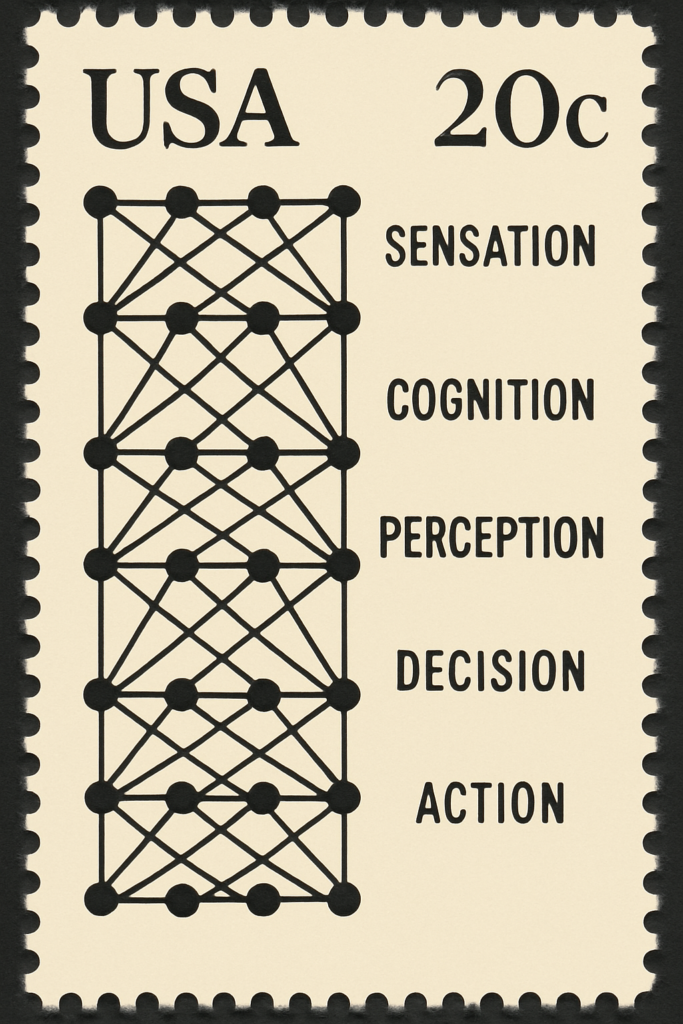
Persuasion is not simple.
It’s not say the right thing, and people will do the right thing.
That’s not how people work.
Because that’s not how the brain works.
The brain isn’t a conveyor belt.
Input doesn’t trundle in at one end and march out the other like cans of beans.
It plunges into a tangle of nets, crosses hidden bridges, comes out wearing a mask you didn’t expect.
The same input doesn’t always lead to the same outcome.
The wiring changes.
The path isn’t fixed.
It’s non-deterministic.
What happens next depends on too many things—most of them hidden.

Everything begins with sensation.
You see something.
You hear a sound.
You taste something sharp or sweet.
It lands in a system that’s busy, messy, and always changing.
The same sound won’t hit the same way every time.
You might ignore it one day.
The next day, it might make your heart race.
It depends on things you can’t always see.
How tired you are.
What mood you’re in.
What memories are floating just below the surface.
Whether you’ve had coffee, slept well, or fought with someone an hour ago.
So even before you start thinking, the signal has already been shaped.
Sensation feeds cognition.
That’s where comparisons live.
Pattern‑spotting, label‑making, story‑stitching.
One smell of smoke makes you salivate.
Another makes you sprint for the door.
Same input, different wiring.
The mesh decides which pattern lights up.
Cognition slides into perception—the moment data becomes meaning.
A grin can be welcome or warning.
Two people shoulder‑to‑shoulder notice the same facts; only one feels safe.
Perception triggers decision—but there’s not just one path forward.
There are many possible directions the mind could go.
Each one calls out.
Habit says go this way.
Fear points to another.
Pride argues for its own.
They all compete at once, pulling the mind in different directions.
Whichever pulls hardest in that moment decides the action.
But change the context, and a different voice wins.
Decision turns into action—that’s the part everyone sees.
It’s the final move, the visible outcome.
But try to trace it back, ask why it happened, and the trail disappears.
Too many layers, too many hidden steps along the way.
It’s easy to predict what groups might do in general.
But a single person?
Too many twists in the wiring.
Too many ways the signal could’ve gone.
Many marketers still group others by age, income, or where they live.
If you’re 25 and live in a city, you’ll behave like every other 25-year-old in a city.
But that’s surface-level stuff.
It tells you what someone looks like, not how they think.
And definitely not how they decide.
Some people act fast.
They feel something, they do something.
Perfect for impulse buys.
Others overthink everything.
They need proof, safety, time.
They need guarantees, not flash.
You can’t talk to both the same way.
You have to change how you speak depending on how their brain moves.
Some minds are shaped by habit.
They’ll always take the same route.
Others only respond when something unusual shakes them.
That’s why persuasion isn’t a formula.
It’s a guess—but an educated one.
The better you understand the path their mind takes,
The better your chances.
So start small.
One person.
Figure out how their mind works.
Try something.
Watch how they respond.
Tweak it.
When it works, you’ve got a pattern.
Now find others who think like that.
Speak to them the same way.
Suddenly, you’re not guessing anymore.
It feels personal—because it is.
Even if you’re saying it to a thousand people.
You don’t need to impress the crowd.
You need to understand how a few types of people tick.
Treat people like machines, and they freeze up.
Treat them like people, and they move.
Win the way someone thinks,
and you win what they do.
Remember to always keep all human matters 1:1 and tailor fitted
Even in cases you are talking with millions of people at once
It must still be 1:1 communication.